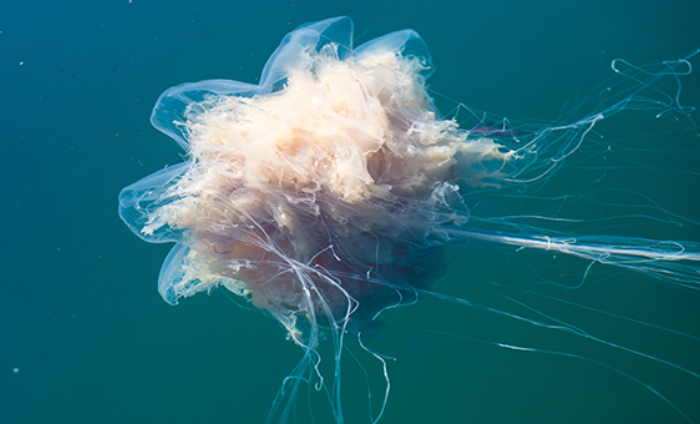
Jellyfish: the definitive guide for open water swimmers
Few things in the world of open water swimming generate the same level of confusion, contradictory information and fear as jellyfish do.
Despite their ability to mesmerise with their striking colours, graceful pulsating movements and other-worldliness, their presence can reduce even the toughest of swimmers into a wobbly jelly and make a chlorinated pool swim feel like an enticing alternative.
The sea creatures we commonly refer to as ‘jellies’ can instil fear in both novice and experienced swimmers alike, so this guide is designed to give you all the information you need to develop a jellyfish strategy to banish your fear, be prepared and stay safe in the water.
What the experts say
Dr. Lisa-ann Gershwin, jellyfish research scientist and author of Stung!, who acts an adviser on jellyfish to Australian long-distance swimmer Chloe McCardell, says research is vital. “My advice for [open water] swimmers is to do some research and arm themselves with information so that they can make informed decisions about when and where to swim.”
Dr. Peter Richardson, Head of Biodiversity at the Marine Conservation Society, says: “Lion’s mane, Portuguese man-o-war and mauve stingers are the three species to be aware of around the UK. There are many other species present in our waters but none of them have a sting to compare to those three.”
An average of 100 jellyfish stings per year are treated by RNLI lifeguards across the total of 240 beaches they patrol across the UK and Channel Islands. “These are treated as minor first aids resulting in a minor rash, which require no further medical intervention,” says Brett Shepherd, RNLI Operations Manager (Lifeguards).
“The good news for swimmers in the UK is that the jellyfish here are low risk compared to other parts of the world,” he adds, noting that he’d worked in Australia where box and Irukandji jellyfish pose serious risks to swimmers.
Salud Deudero PhD of the Spanish Oceanographic Institute is based in Palma, Mallorca and coordinates the collection of data on the presence of jellyfish around the Balearic Islands. This information is fed into the CIESM JellyWatch Program, which records the frequency and extent of jellyfish outbreaks across the Mediterranean Sea.
“Jellyfish are present the whole year round, but in summer most individuals can be found near shore and in coastal waters,” says Deudero, explaining that various factors influence the prevalence and movement of jellyfish including sea currents, weather conditions, predators, nutrient levels in the water and the presence of jellyfish foodstuffs including algae and zooplankton.
To pee or not to pee?
Jellyfish sting their targets by discharging many thousands of microscopic stinging capsules. These are located on the surface of tentacles and in some species on the body of a jellyfish. These capsules contain coiled threads loaded with venom. Upon contact, they discharge into the victim’s skin like mini-harpoons.
Stinging cells from different species of jellyfish are either inhibited or stimulated to discharge by different substances used for first-aid. There is a plethora of contradictory advice around in relation to the treatment of stings with the age-old question of ‘To pee or not to pee?’ continuing to spark many a pub debate.
The consensus from experts in the field is that it is not recommended to urinate on a jellyfish sting regardless of how keen your fellow swimmers might be to assist.
“You’d be amazed at the things people tell me they use on stings, including everything from butter to baking soda and shaving foam. I even had one guy insist that a jellyfish sting should be treated like a margarita and doused in tequila, lime juice and salt!” says Dr. Gershwin. “The two definite no-nos are fresh water and alcohol as both will make the situation significantly worse,” she adds.
With jellyfish sting treatment there is no simple “one size fits all” advice and different species require different responses. As a result much confusion has arisen over what to do when stung and in some cases getting it wrong can mean the difference between life and death.
Dr. Angel Yanagihara, PhD research professor, SOEST and Dept of Tropical Medicine University of Hawaii, is a world expert on the potentially lethal box jellyfish and acted as a consultant to US endurance swimmer Diana Nyad for her 52-hour crossing from Cuba to Florida in 2013.
Her advice to open water swimmers is to not swim when dangerous species are present. “If swimming is an utter priority, the next best advice is to use proper protective wear such as a non-buoyant exposure suit,” she says.
Dr. Yanagihara has developed a sting relief product called Sting No More available in a spray and a cream and makes to order an anhydrous lanolin based version for long distance ocean swimmers.
A range of other products are available which claim to repel jellyfish or treat stings (see panel) but Dr. Gershwin is sceptical. “Maybe these commercially available products provide a bit of protection over nothing at all but I’m more concerned about people exposing themselves to a greater risk because they believe they are protected,” she says.
In the past, Australian lifeguards donned women’s tights to protect themselves from stings and a few surfers still use this tried and tested barrier method, although most now favour a wetsuit or Stinger Suit in high-risk areas.
Stings happen: deal with it
Simon Murie, owner of adventure swimming tour operator SwimTrek, says: “We take over 2,000 clients on trips to 18 countries around the world each year. In the 13 years we’ve been operating we’ve had no recorded cases of serious reactions or hospitalisations as a result of jellyfish stings.
“Jellyfish can be present on any sea swim but in a lot of cases either the jellyfish does not sting, they are located a few metres below the surface or the sting is very mild. Where stings can potentially be a bit more painful, we work on contingency options to minimise our exposure and in a few rare cases we have moved trips due to the high prevalence of jellyfish as was the case with Gozo and Sicily,” he says.
UK-based marathon swimmer Ed Williams swam the North Channel in August 2016 following an unsuccessful attempt in 2014. He proved that one bad jellyfish experience does not always deter a swimmer from going back to make another attempt.
He aborted his 2014 attempt when he experienced breathing difficulties after sustaining a significant number of Lion’s Mane stings. He recounts being “wrapped in tentacles” and being “stung on the mouth”.
“It was all the more satisfying for not having made it the first time. Second time round I knew they’d be there and decided to embrace them. Strangely the stings didn’t hurt anywhere near as much as the first time. In fact the anticipation of being stung was worse than the sting itself”.
Asked if he considered wearing protective clothing such as a Stinger Suit for his second attempt, he replies: “No, I was determined to do it by the book. Many people outside the [open water swimming] community suggested that, but as far as I was concerned it was one of the rules.”
Originally drawn up for the English Channel where no deadly jellyfish are present, some experts are questioning whether these rules are appropriate for swims in other parts of the world where potentially lethal species pose a serious risk to swimmers.
Dr. Gershwin thinks it is time to review the rules for swims where harmful jellyfish are present. “There have been numerous very high profile life-threatening cases of stings to channel swimmers, and I can’t help but wonder if there may be others unreported, and maybe making protective clothing at least optional wouldn’t be a bad thing in the interest of safety,” she says.
This is a view echoed by Dr Yanagihara who says she “does not understand the current rules” which dictate that swimmers only wear a swimsuit or trunks. “I feel that just as motorway safety dictates the wearing of a helmet, the sport of open ocean swimming should acknowledge the life threatening impact of certain jelly stings. I feel that safety of the athlete is a critical concern that should be addressed by regulatory and ruling bodies in the open ocean swimming community.”
Pressure to review the rules might well increase if jellyfish blooms continue to increase around the world. In her book Stung! Dr Gershwin notes that jellyfish bloom increases go hand in hand with ecosystem degradation.
“Overfishing, a rise in water temperature, high mineralisation and a reduction in number of pelagic fish [jellyfish predators] are creating a perfect environment for jellyfish to bloom. They flourish in dead zones where other creatures can’t survive and this trend could well continue,” Dr Gershwin says.
Despite the prospect of rising numbers of jellyfish in our seas, the vast majority do not pose any serious risk to open water swimmers, and many make excellent subjects for underwater photography with their vibrant colours and alien-like shapes.
“Don¹t worry too much about jellyfish. The joys of open water swimming come from the unpredictability of your environment,” says Simon Murie of SwimTrek.
“Quite often those most afraid of jellyfish are those who haven’t been stung yet. Once you have been, you may wonder what all the fuss was about.”
7 tips for staying ‘jelly safe’ in the open water
- Do your research. Ask other swimmers, lifeguards and fishermen whether jellyfish are present, which species and get information about how to treat stings. Make sure you have everything you need to administer treatment to yourself or others if stung.
- Understand local conditions in relation to wind and tides as these factors influence the movement of jellyfish. Scan the water from shore before getting in.
- If stinging jellyfish are present, swim at a lifeguarded beach so that assistance is on hand if needed.
- If stung on the face, particularly around the mouth and nose, or if you experience breathing difficulties, get out of the water and seek medical attention.
- Use one of the apps that are available to record jellyfish sightings. Check out whether jellyfish have been spotted recently before you swim and upload information about the jellyfish you see. Keep the databases up to date to help other swimmers. Two options are jellywatch.org and jellyrisk.eu. In the UK you can also submit sightings to the Marine Conservation Society for its annual Jellyfish Survey. Visit: www.mcsuk.org.
- If stinging jellyfish are around, wear protective clothing such as a rash vest, wetsuit or Stinger Suit. If you are swimming under rules that preclude wearing more than a swimsuit or trunks cover as much as possible to limit the amount of skin exposed. For women a high-necked suit will stop jellies from slipping down the front.
- Remember, many jellyfish don’t sting and the majority of those that do only cause mild discomfort like a nettle sting. In many cases the fear far outweighs the risk, so don’t let jellies get in the way of your enjoyment of the open water.
You may also like our tips for sea swimming.








